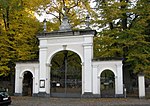University of Regensburg

The University of Regensburg (German: Universität Regensburg) is a public research university located in the city of Regensburg, Germany. The university was founded on 18 July 1962 by the Landtag of Bavaria as the fourth full-fledged university in Bavaria. Following groundbreaking in 1965, the university officially opened to students during the 1967–1968 winter semester, initially housing faculties in Law and Business Sciences and Philosophy. During the summer semester of 1968 the faculty of Theology was created. Currently, the University of Regensburg houses eleven faculties. The university actively participates in the European Union's SOCRATES programme as well as part of the Compostela-Group. Its most famous academic, the previous Pope Benedict XVI, served as a professor there until 1977 and formally retained his chair in theology.
Excerpt from the Wikipedia article University of Regensburg (License: CC BY-SA 3.0, Authors, Images).University of Regensburg
Universitätsstraße, Regensburg Galgenberg
Geographical coordinates (GPS) Address Nearby Places Show on map
Geographical coordinates (GPS)
| Latitude | Longitude |
|---|---|
| N 48.99923 ° | E 12.09317 ° |
Address
Sammelgebäude Hörsaalgebäude
Universitätsstraße 31
93053 Regensburg, Galgenberg
Bavaria, Germany
Open on Google Maps










